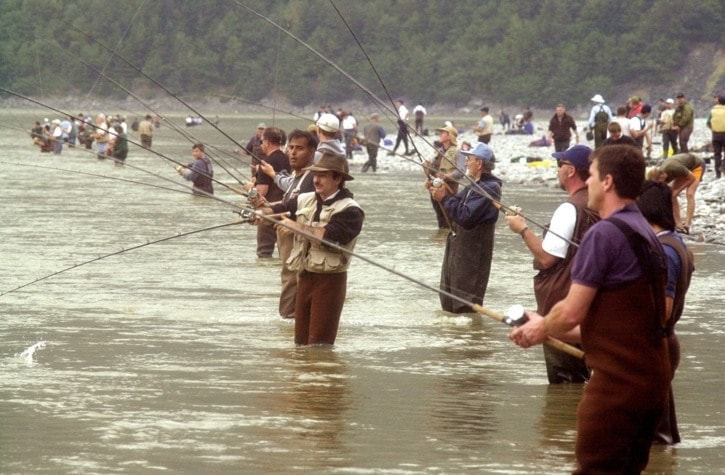A large portion of the Chilliwack recreational fishing industry has come to an abrupt halt as the government shut down the Fraser River to salmon fishing.
Up to 70 per cent of sockeye salmon in the Fraser are expected to die before reaching spawning grounds, according to Fisheries and Oceans Canada.
Fishing for any type of salmon in the river from the Mission bridge to the Alexander Bridge past Yale was suspended as of Friday until further notice.
The reasons for the closure are the record-high in-river temperatures of 20 to 22 °C as well as lower than expected sockeye returns.
The heat impairs swimming, causes disease outbreaks, and rapidly deteriorates the health of the fish, explained Les Jantz, DFO area director for the B.C. Interior.
Ideal temperatures for spawning are 16 to 18 °C.
The run, at an estimated 3.2 million fish, is also smaller than the earlier forecast of 4.7 million.
"That's why we've closed fishery. We're trying to get more fish into the river so that the 30 per cent that do survive, we maximize the number," said Jantz.
Although the concern is primarily about the sockeye, fishing of all species has closed because of the risk of catching sockeye as bycatch.
But fishing is still permitted where the Fraser meets the Strait of Georgia, where the main method is troling from a boat. This results in "very very low" incidents of sockeye bycatch, according to Jantz.
Further up the Fraser, however, some anglers choose to use "bottom-bouncing" or "flossing," a technique using long leader lines in which they have little control over which salmon get hooked.
"Any additional stress that is put on those fish right now is not a good thing," said Jantz.
Chilliwack Fishing guide Dean Werk, with Great River Fishing Adventures, said if there is a serious conservation concern there should be "no fishing anywhere" including in the marine approach, like the West Coast of Vancouver Island, where most of the sockeye are right now.
Bottom-bouncers are not on the river in large numbers at the moment, compared to when there's a retention fishery for sockeye, he said.
He was talking to the Progress while guiding in the Fraser Canyon, near Hope, with visitors who flew into Chilliwack from out of province specifically for the chance to fish sturgeon.
"We have done three years of hook and release mortality studies that clearly show a less than two per cent mortality on sport-caught sockeye salmon," he said.
But federal Fisheries will not use these mortality study results to manage the fishery.
"We have shown clearly that we can fish for both chinook and pink salmon with an almost non-measurable impact."
Werk said his company is fielding a number of cancellations due to the closure, including an 11-person group that was booked to fly in from Edmonton. That's travel plans, hotel rooms, restaurant meals, all cancelled.
"There's going to be an immediate economic impact for all the guide companies, for the hotels, for the tourism-related businesses that were going to benefit from the visitors coming into the community to take advantage of doing some salmon fishing this summer," said Brian Coombes, executive director of Tourism Chilliwack.
Great River Fishing Adventures alone does $1 million worth of fishing trips annually.
Coombes added that those visitors disappointed by the closure this year are less likely to return.
"There's also a credibility issue as well. There's a lot of money spent raising awareness about the sport fishing opportunities in the Fraser River and our area; to try to attract sport fishing enthusiasts here."
Once the sockeye run is near completion, possibly as early as September, the government may reopen the Fraser to fishing of other salmon species.
"We anticipate at this point that there will be other recreational and First Nations fishing opportunities on other species, like pink salmon and chum salmon. At this point, this closure is specifically to try to get the sockeye through, as many as we possibly can. And when the sockeye returns begin to dissipate, then we will be looking at other opportunities," said Jantz.
The unusually high air temperatures this summer have led to a lack of rainfall and below average water levels in the Fraser, which in turn has led to higher water temperatures. These reached similar heights in 2004, but later in the season. Prior to that, temperatures was similarly high in 1998.
The last time that the fishing season ended so early was in 2009, when only 1.5 million salmon returned from the projected 10 million. This year's salmon are returning from the collapse of that year.
Fishing for trout, steelhead, sturgeon and other non-salmon species on the Fraser remains open.
akonevski@theprogress.com twitter.com/alinakonevski* this is a modified version of the original story in which some factual errors were corrected, including the location of the fishing guide during the interview, which was on the Fraser RIver, and not the Hope River.